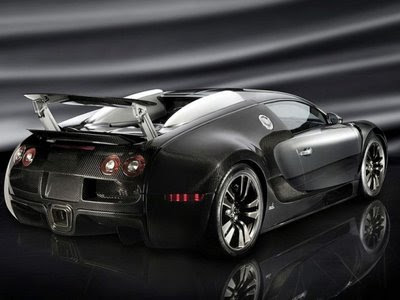Creating Engine
Bugatti did two things to create a compact machine capable of producing 1,000 hp. The first and most obvious is turbocharging.
Bugatti Veyron
The Bugatti Veyron's 16-cylinder engine giant that produces 1001 horsepower for a top speed of more than 250 mph. And it is the passenger car.
If you've read How Turbochargers Work, you know that one easy way to create more powerful machines without making bigger engine is the way things are more air into the cylinder on each intake stroke. Turbochargers do that. A turbo pressurizes the incoming air into the cylinder so the cylinder can hold more air.
If your goods twice as much air in each cylinder, you can burn twice as much gasoline. In fact, it was not quite perfect ratio like that, but you get the idea. The Bugatti uses a maximum turbo boost of 18 PSI to double the power output of the engine.
Therefore, Bugatti turbocharging allows for the cut size from 16-liter engine returned to a more manageable 8 liters.
To produce a lot of air pressure, the Bugatti requires four separate turbochargers arranged around the engine.
To maintain a high RPM redline, and to reduce the lag time when you press the gas pedal, is to double the number of cylinders. The Bugatti has a very rare 16-cylinder.
There are two easy ways to make a 16-cylinder engine.
* One way is to put two V-8 engines in-line with one another. Then you connect the output shaft of the two V-8 together.
* After that put the two 8-cylinder line beside each other.
This last technique, in fact, is the first way to create 16-cylinder Bugatti cars in the early 20th century
For the Veyron, Bugatti choose a more challenging path. Essentially, Bugatti merged two V-8 engine into one another, and then let them both the same crankshaft. This configuration creates W-16 engine found in the Veyron
Bugatti did two things to create a compact machine capable of producing 1,000 hp. The first and most obvious is turbocharging.
Bugatti Veyron
The Bugatti Veyron's 16-cylinder engine giant that produces 1001 horsepower for a top speed of more than 250 mph. And it is the passenger car.
If you've read How Turbochargers Work, you know that one easy way to create more powerful machines without making bigger engine is the way things are more air into the cylinder on each intake stroke. Turbochargers do that. A turbo pressurizes the incoming air into the cylinder so the cylinder can hold more air.
If your goods twice as much air in each cylinder, you can burn twice as much gasoline. In fact, it was not quite perfect ratio like that, but you get the idea. The Bugatti uses a maximum turbo boost of 18 PSI to double the power output of the engine.
Therefore, Bugatti turbocharging allows for the cut size from 16-liter engine returned to a more manageable 8 liters.
To produce a lot of air pressure, the Bugatti requires four separate turbochargers arranged around the engine.
To maintain a high RPM redline, and to reduce the lag time when you press the gas pedal, is to double the number of cylinders. The Bugatti has a very rare 16-cylinder.
There are two easy ways to make a 16-cylinder engine.
* One way is to put two V-8 engines in-line with one another. Then you connect the output shaft of the two V-8 together.
* After that put the two 8-cylinder line beside each other.
This last technique, in fact, is the first way to create 16-cylinder Bugatti cars in the early 20th century
For the Veyron, Bugatti choose a more challenging path. Essentially, Bugatti merged two V-8 engine into one another, and then let them both the same crankshaft. This configuration creates W-16 engine found in the Veyron





Tidak ada komentar:
Posting Komentar